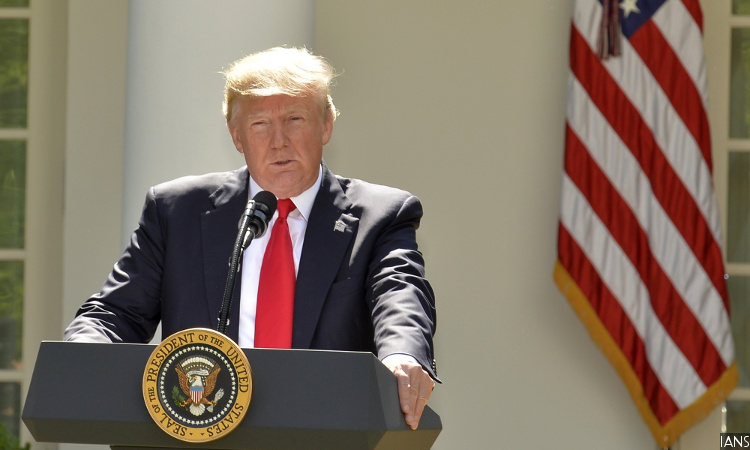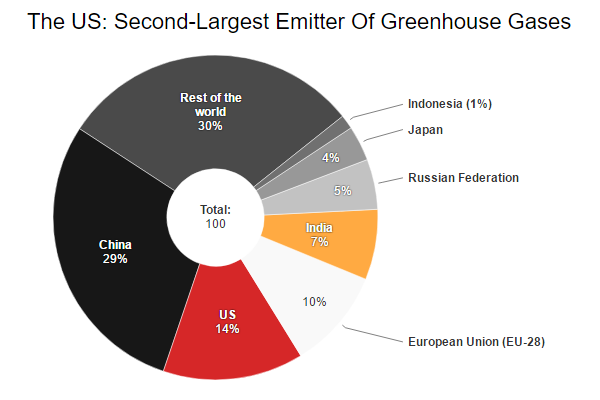Trump Disses India On Climate Change, Gets It Wrong

Early on the morning of June 2, 2017, the President of the United States (US), Donald Trump, announced that the world’s second-largest polluter was exiting the Paris Climate Accord--the global agreement that aims to address the planet’s warming--declaring it unfair to the US.
In the course of his speech, Trump--who has previously questioned climate change--made five claims, two specific to India, that were incorrect, FactChecker found.
Trump’s claim: “India makes its participation contingent on receiving billions and billions and billions of dollars in foreign aid from developed countries...But the bottom line is that the Paris Accord is very unfair, at the highest level, to the United States.”
Fact: While estimates for the costs of adaptation to climate change vary, they could range from US $140 billion to US $300 billion by 2030, and between US$280 billion and US$500 billion by 2050, according to the 2016 Adaptation Gap Report from the United Nations Environment Programme.
The Paris Agreement states: “Developed country Parties (sic) shall provide financial resources to assist developing country Parties with respect to both mitigation and adaptation in continuation of their existing obligations under the Convention.”
India is committed to remain a part of the Paris Agreement, but will not fill the gap, either in terms of funds or emissions, that the US’s exit will cause in the international effort under the agreement, the Business Standard reported on June 1, 2017.
Trump’s claim: “India will be allowed to double its coal production by 2020. Think of it: India can double their coal production. We’re supposed to get rid of ours.”
Fact: In 2015, the US was still producing more coal and lignite than India. While the US produced 820 million tonnes (Mt), India’s production was 764 Mt, 23.2% and 21.6% respectively, of the 3,538 Mt that China produced, according to the 2016 Global Energy Statistical Yearbook. The Paris Agreement, however, does not put a global moratorium on coal, as Politifact reported on June 1, 2017.
If India manages to achieve its renewable-energy targets (of installing 175 GW of renewable power by 2022), it will not need to install any more coal-fired power plants until 2027, in line with its aim to achieve a low-carbon economy, as IndiaSpend reported on April 29, 2017.
Coal-fired power plants caused a third of global carbon dioxide (CO2) emissions in 2015, according to this 2016 joint report by the PBL Netherlands Environmental Assessment Agency and the Joint Research Centre of the European Commission.
“The continuing rapid growth in renewable energy in India, combined with sustained reductions in coal imports and a slowdown in coal development—with coal-fired ultra-mega power projects cancelled—is a strong indication that the low carbon transformation of India’s energy supply sector is gathering momentum,” according to this analysis by Climate Action Tracker, an independent scientific analysis produced by three research organisations tracking climate action since 2009.
“With China continuing to reduce its coal and CO2 emissions, the ongoing growth of renewable energy and slowdown of coal in India is the most important development underway globally today,” the analysis further stated.
“His (Trump’s) contention that the Paris Agreement hamstrings the US while allowing India and China to increase their emissions is baffling,” Lavanya Rajamani, professor at New Delhi’s Centre for Policy Research, a nonprofit, said in a statement. “The Agreement allows every country to 'nationally determine' its contribution (NDC), and, it does not oblige them to achieve these.”
Trump’s claim: “The Paris Climate Accord is simply the latest example of Washington entering into an agreement that disadvantages the United States to the exclusive benefit of other countries.”
Fact: At the end of the Conference of Parties 20 (the name for the governing body of the United Nations Framework Convention on Climate Change), held in December 2014 in Lima, Peru, all countries submitted their plans of climate action--known as Intended Nationally-Determined Contributions (INDCs)–including emission targets as per the Lima Call for Climate Action.
Each country set its own targets, which were voluntary. Barack Obama, former US president, had pledged to reduce US emissions by 26%-28% below 2005 levels by 2025, as Politifact reported on June 1, 2017.
“The perceived 'unfairness' Trump alludes to stems not from an internationally prescribed target--the Paris Agreement contains none--but a 'nationally determined' contribution chosen by the previous US administration of its own volition,” Rajamani also said in her statement.
Trump also said in his speech that he “was elected to represent the citizens of Pittsburgh, not Paris.” to which the Mayor of Pittsburgh, Bill Peduto tweeted that “as the Mayor of Pittsburgh, I can assure you that we will follow the guidelines of the Paris Agreement for our people, our economy & future.”
As the Mayor of Pittsburgh, I can assure you that we will follow the guidelines of the Paris Agreement for our people, our economy & future. https://t.co/3znXGTcd8C
— bill peduto (@billpeduto) June 1, 2017
Trump’s claim: “Not only does this deal subject our citizens to harsh economic restrictions, it fails to live up to our environmental ideals. As someone who cares deeply about the environment, which I do, I cannot in good conscience support a deal that punishes the United States — which is what it does – the world’s leader in environmental protection, while imposing no meaningful obligations on the world’s leading polluters.”
Fact: In 2015, The US was the second-largest emitter of greenhouse gases (GHG), accounting for 14% of the world’s total emissions, while India’s was 7%, according to this 2016 joint report by the PBL Netherlands Environmental Assessment Agency and the Joint Research Centre of the European Commission.

Source: Trends in Global CO2 Emissions Report
Trump’s claim: I will work to ensure that America remains the world’s leader on environmental issues, but under a framework that is fair and where the burdens and responsibilities are equally shared among the many nations all around the world.
Fact: The Paris Agreement was based on the principles of “common but differentiated responsibilities and respective capabilities, in the light of different national circumstances”.
Article 4 of the Agreement stated, in accordance with the polluter-pays principle: “Developed country Parties should continue taking the lead by undertaking economy-wide absolute emission reduction targets. Developing country Parties should continue enhancing their mitigation efforts, and are encouraged to move over time towards economy-wide emission reduction or limitation targets in the light of different national circumstances.”
A framework that equally burdens nations with mitigating climate change without taking historical pollution and/or state of development into account would, in fact, be unfair.
It is also unlikely that the US will remain a world leader on environmental issues, having isolated itself from most of the world, which is still committed to the Paris Agreement. Other national governments and regions are already adopting a climate-leadership role – including the US state of California, which said it would stand by the Paris Accord – and, China and India, according to this analysis by Climate Action Tracker.
The EU and China too, confirmed their commitment to the Paris Agreement, according to this joint statement.
(Patil is an analyst with IndiaSpend and FactChecker.)


